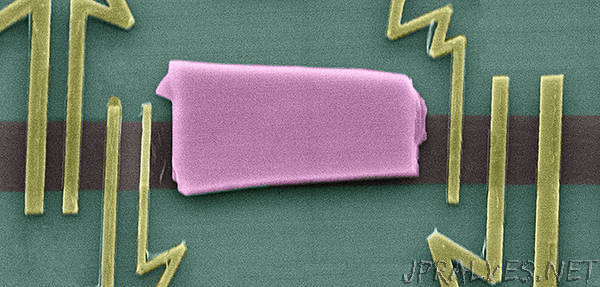
“A hybrid electronic device consisting of graphene and topological insulators have been demonstrated by researchers at Chalmers University of Technology in Sweden. The findings in the hybrid devices reveal a unique electronic spin functionality which is not present in the individual materials. The results were recently published in the prestigious journal Science Advances.
In quantum physics, spin-orbit coupling is a relativistic interaction between the spin and momentum degrees of freedom of electrons. It is central to the novel topological phenomena observed in condensed matter physics and in practical use for various spintronic and quantum technologies. For example, the discovery of spin dependent electronic scattering phenomenon in solids by Nobel Laureates Albert Fert and Peter Grünberg has given rise to computer data storage, memory and sensor applications.
Recently, the newly discovered two-dimensional materials have provided an emerging platform to discover new spin dependent interactions because of its unique electronic properties.
“After the discovery of graphene by Nobel Laureates Andre Geim and Konstantin Novoselov, it has been a long-standing goal for researchers to generate a large spin-orbit coupling in the material for creation of novel topological quantum effects and to observe new spintronic phenomenon”, says Saroj P. Dash (above picture), Associate Professor at Chalmers and leader of the experimental group at the university.
However, graphene does not have the sufficient spin-orbit interaction, because it consists of a single two-dimensional layer of light carbon atoms arranged in a symmetrical hexagonal lattice.
Here, researchers demonstrated an emergence of a large spin-orbit coupling and predicted a creation of nontrivial spin texture of electronic states in graphene, by the formation of a heterostructure built from two electronically special materials – graphene and topological insulators.
“The idea here was to modify the graphene properties by a proximity effect while hybridizing with a high spin-orbit material such as topological insulator”, says Saroj P. Dash.
The heterostructures of graphene and topological insulators were assembled by layer-by-layer transfer of these two materials, which are ultimately bonded by a van der Waals force. In a strong collaborative research effort, the theoretical calculations for such heterostructures were performed at Catalan Institute of Nanoscience and Nanotechnology (ICN2) in Spain and the device fabrication and electronic measurements were performed at Chalmers in Sweden.
“This has been possible by utilizing the state of the art nanofabrication facility and spin-sensitive electronic measurements at Chalmers”, says Saroj P. Dash.
Dmitrii Khokhriakov is a PhD Student at Chalmers and first author of the scientific paper:
“The chosen materials in the hybrid devices, such as graphene and topological insulators, share similar linear energy band spectra for electrons, following a Dirac relation rather than obeying the usual Schrödinger equation. The key difference between these two materials lies in their spin-orbit coupling strength. The advantage of these heterostructures is that, while graphene in proximity with topological insulators still supports good spin current, it concurrently acquires an induced strong spin-orbit coupling”, he says.
Stephan Roche is Professor at ICN2, and leader of the theory team:
“The proximity-induced strong spin-orbit coupling not only triggers the emergence of novel fundamental spintronic features, but also could open new avenues for exploring proximity induced topological effects in the field of spintronics and quantum computing. They could become important building blocks in future spin-based data storage or information processing technologies”, he says.
The research at Chalmers is supported by Excellence Initiative Nano and Graphene Centre at Chalmers, The Swedish Research Council (VR), EU Graphene Flagship and FlagEra projects.”
